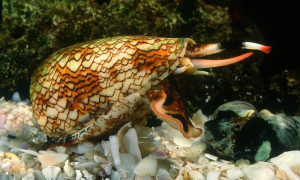Treatment breakthroughs for insulin and chronic pain haven’t been moving at a snail’s pace—and those shelled gastropods may in fact be the key to a momentous breakthrough in these spaces. In two recently published studies, University of Utah researchers report that the highly potent venom with which cone snails stun and sedate their prey could fuel advancements in fast-uptake insulin and somatostatin-analog pain relief. One of the studies found that a peptide known as Consomatin Ro1 in the venom of a specific cone snail type, upon injection into mice, produced results similar to those of morphine.
Still to be determined is if Consomatin Ro1 is a better candidate than the already available somatostatin analogs. “The advantage with the cone snails . . . is that there are so many species,” said Dr. Helena Safavi, co-author of the more recent study. “And we know that many of these species make somatostatin, so the chances of finding the best analog might be pretty high.” The other study noted that the plethora of potentially usable venom formulations is a boon for future effective insulin breakthroughs.
Researchers have investigated snail venom for pain medication breakthroughs in the past. Prialt, a potent chronic pain med developed by Elan and owned by TerSera Therapeutics that earned FDA approval in 2004, was built around similar cone snail venom research that also originated from the University of Utah.























